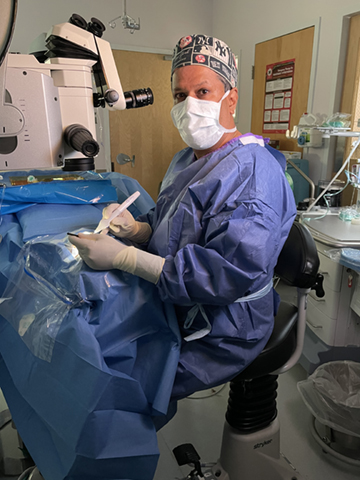Cataract Surgery
Cataract surgery is one of the most common surgical procedures done in the United States and around the world. It involves removing a cloudy lens inside the eye and replacing it with a new, clear artificial lens. This surgery is performed on people who have developed a cataract, which usually occurs as the natural lens of the eye ages and becomes cloudy or opaque. However a number of conditions such as genetics, diabetes, rheumatologic diseases, medications, and trauma can cause early presentation. Cataracts cause vision impairment or loss, and surgery is often the best way to restore vision.
Cataract Symptoms






Cataract Surgical Techniques

There are several types of cataract surgery, but one of the most modern is known as phacoemulsification involving minimally-invasive techniques that are exceptionally efficient. During this procedure, a small incision (usually less than 2.4 mm) is made in the cornea, and a tiny ultrasound probe is used to break up the cloudy lens into small pieces. The fragments are then suctioned out, and an artificial lens is inserted into the same position as the natural lens.
Our surgeons have national and regional reputations employing the latest in cataract surgical techniques, including no-stitch/no-needle cataract surgery, topical anesthesia ensuring faster recovery times, and expertly combined cataract surgery with other minimal invasive techniques. In fact, DrJ was named to the “Ocular Surgery News Top 300 Premier Cataract Surgeons” in the country years ago and has empowered all of us to follow the same track of excellence.
Optimal visual outcomes and the best ocular health possible is what every person desires. With this in mind, we use only the best, most up-to-date intraocular lenses (IOLs) utilizing a variety of monofocal (latest technology), toric, and multi-focal/depth of focus IOLs from leading manufacturers including Alcon, Bausch & Lomb, and Johnson & Johnson Vision. We work with the top and trusted companies to make sure our consumers get a tailored approach that is not only modern but FDA-approved. Our affiliated surgical centers and operating rooms are “best-in-class” with not only top equipment but nationally-ranked nursing services. In addition, our affiliate surgical centers offer physician-run anesthesia services, ensuring the highest level of comfort. Surgery is stressful and we aim to lessen that anxiety as much as possible throughout the journey.
Are You Experiencing the Early Effects of Cataracts?
Take our Cataract Self-Test to find out if you are a candidate for Cataract Surgery
Anterior Segment Surgery
Anterior segment surgery is another type of eye surgery that involves treating various conditions that affect the front of the eye, including but not limited to combined cataract surgery with minimally-invasive glaucoma surgery (MIGS), & corneal and ocular surface procedures. These types of surgeries may be performed to correct problems resulting from trauma, infection, and many inflammatory conditions causing corneal damage or scarring, early to moderate glaucoma, and other disorders of the anterior segment which certainly affect vision.
Overall, cataract and anterior segment surgeries are effective procedures meant to restore vision and improve eye health. Patients who are considering these types of interventions should consult with one of our experienced eye surgeons to discuss the risks and benefits of each procedure to determine the best course of action for their individual needs. Our doctors speak and lecture at local, regional, national, and even international meetings to not only educate but learn from other top surgeons in the ever-growing and expanding field of eye surgery.
It’s “EyeCare because WeCare!”
